Something’s coming: How US companies can build resilience, survive a downturn, and thrive in the next cycle
July 30, 2022

The signs are unmistakable: despite the contraction of GDP at an annual rate of 1.6 percent in the first quarter of 2022, the US economy has been running hot—very hot. Inflation is the highest it has been since the 1970s. The labor market has climbed out of its pandemic hole and is almost as tight as it’s ever been; there are nearly twice as many listed job openings as unemployed people. Prices for gasoline, diesel, and natural gas have doubled or more since 2020. Ocean-shipping costs are up nearly fivefold, trucking costs by 30 percent.
To many, these are indicators of an unsustainable economic boom. Indeed, the US Federal Reserve has raised rates to slow down growth and inflation, and the first estimate of second-quarter GDP, published on July 28, shows a decline of 0.9 percent at an annualized rate. But how will this slowdown—if that’s what it is—play out? Here, the signals are more mixed. Consumer and corporate cash balances are ealthy. Corporate and consumer defaults are at historical lows. Yet consumer economic sentiment is the lowest it’s been since it began to be measured, in 1953, and corporate confidence isn’t much better. 1 Equity markets have undergone a painful reset but now seem to be rebalancing in an orderly fashion.
Is this the end of a boom, the beginning of a bust, or something different? In our latest survey of business executives, more than half said that a recession is due to arrive this quarter or next and will last, in the most pessimistic scenario, for up to five quarters. But nearly half thought a recession could be avoided.
Something’s coming—we just don’t know what. Whether this moment leads to a turn in the business cycle or to a continuation of recent inflationary trends, it is a time when companies can make the kind of pivot that strengthens their growth trajectory for the next several years. Our research indicates that the moves companies make now could account for half of the difference in total shareholder returns (TSR) between leading and lagging companies over the next business cycle. It’s therefore critical for leaders to get their next steps right.
Companies head into this uncertainty with different degrees of readiness and health. Most fall into one of four camps:
- Some are poised to thrive. They enjoy relatively inelastic demand for high-margin products, find it relatively easy to attract and retain talent, and have blessedly simple supply chains. Financially, they have strong balance sheets, low leverage, and ample cash. For them, the strategic options are multiplying.
- Other companies are more constrained. Their varied challenges include greater susceptibility to a slowing economy, recent loss of market share to new entrants, thinner margins now being inflated away, labor challenges, and more complicated supply chains. As a result, their balance sheets can be more challenged. These companies can resolve to reform.
- A third group faces a fight to survive. Their balance sheets are loaded with debt, their cash reserves are dwindling, and some are highly exposed to geopolitical disruption, particularly from Russia’s war in Ukraine.
- Finally, a fourth group of mostly newer entrants has, to date, successfully focused on growth and market share rather than profitability; however, if they do not pivot to profit, more funding will probably be harder to find.
With a wide range of potential economic outcomes in the offing, all four groups should build systemic resilience through foresight (understanding the challenges and opportunities disruptions cause), response (mitigating challenges while taking advantage of opportunities in real time), and adaptation (longer-term strategic pivots to emerge from the disruptions stronger and better positioned for growth—which can help leaders meet longer-term goals of sustainable, inclusive growth for all stakeholders—customers, employees, investors, and the community).
To start responding to the challenges of the present, any company can benefit from establishing a core team to read and comprehend the economic signals, translate them into a range of business implications, and serve as the fulcrum for agile decision making. Such a team can also conduct game planning and scenario analysis to figure out how bad the coming storm might be, the opportunities that might be available, and whether they will require fundamental shifts in strategy. In addition, companies can’t go wrong by moving fast and hard on productivity and cash—raising the ability of their workers to deliver more value per person and controlling costs—to bolster their earnings and preserve their capacity for growth. Beyond that, every company will want to consider the actions best suited to its particular circumstances. This article explains them.
A turn in the cycle is a moment that requires true leadership to embark on either offense or defense. But the best-performing companies don’t wait for that turn to reveal itself—or not: they act with intentionality and courage in the face of profound uncertainty about the macroeconomy. To survive during the COVID-19 pandemic, most companies built new muscles of resilience. This is the time to fortify those core strengths in new ways and to create strategic distance from competitors in the postpandemic future.
The US economy: Conflicting signals
Hard landing or soft? It’s the question of the day. Economic signals rarely point in one direction, but this is an unusually chaotic period. And it’s producing the most complex operating environment in memory for CEOs and other leaders.
Consider how we got here. The COVID-19 pandemic introduced nearly unprecedented and sudden shifts in the national economy: lockdowns, almost empty trains and office buildings, negative (!) oil prices, stimulus checks at unprecedented scale, blistering growth in e-commerce, and many more. Then, just as COVID-19 was becoming endemic, Russia invaded Ukraine, delivering another shock to the global economy. The war’s repercussions are still being felt in the United States and elsewhere. Inflation has soared—in June 2022, the Consumer Price Index was up by 9.1 percent (year on year) and the Producer Price Index by more than 11 percent. Inflation in food prices may be the most concerning effect: the United Nations estimates that world food prices have risen by 50 percent. That has disturbing implications for poor and vulnerable populations in the United States and elsewhere.
At a time like this, forming a view of the economy’s likely direction is even more difficult than usual, so companies ought to avoid a single-point forecast. They can instead consider a set of three scenarios that capture the range of disruptions that could further bedevil the US economy (Exhibit 1).
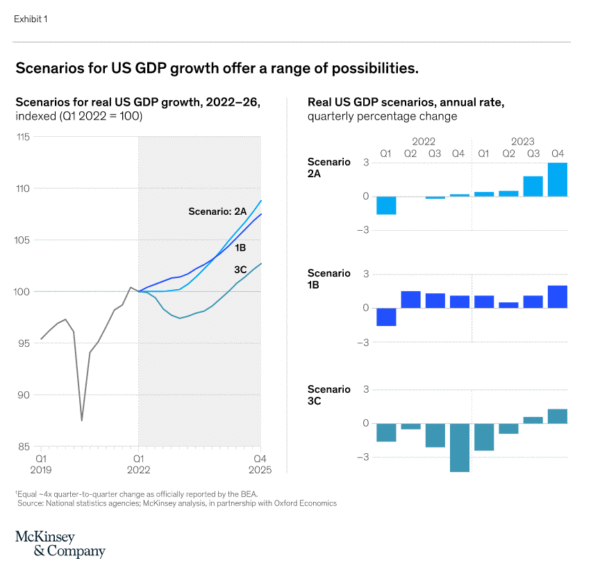
In two of the scenarios illustrated here, growth remains positive or flat across the next several quarters. In the third (3C), we consider a significantly more negative possibility which is consistent with the July 28 GDP report: that the economy was already in a technical recession in the second quarter of 2022 and is falling fast. In this scenario, it will shrink by an annualized rate of 4.3 percent in the fourth quarter of 2022 and return to positive growth only in the second half of 2023. Since June, in a significant loss of optimism, about 30 percent of the economists that Bloomberg tracks now forecast a recession as of July 15, (though the median forecast indicates 1.6 percent growth for the year’s second half.)
Companies need to consider how this range of outcomes could affect their performance, the opportunities these outcomes might create, and whether they call for an urgent and fundamental shift in strategy. Even a small decline in the GDP’s growth rate can have bullwhip effects in some sectors and lead to much greater drops in revenues. The downside risk is material but at present does not seem close to the magnitude of the shocks experienced during the 2008 financial crisis or the height of the COVID-19 pandemic.
Five semi-sure things
Amid all the uncertainty about the country’s economic direction, we suggest that CEOs keep a few things in mind:
- This time is different, for better and worse. The economic environment is much more complex today than it was during the 2008 crisis, which began in the financial system and housing and was easier to track. The complexity is something that very few leaders have seen before. Yet the US economy now has strengths—in labor markets, the health of the financial system, the energy market’s structure, and technology—that it didn’t have in the 1970s or even in 2008.
- Consumers and corporates are in good shape (generally). Both have healthy cash balances. The wages of consumers have risen, and they have significantly less debt than they did in 2008. Corporate defaults remain at historical lows. But these are averages and can obscure the pressing financial problems that many US consumers (and some companies) face.
- Equity markets are not falling apart. Rather, the equity supercycle of 2018 to 2021 is unwinding, with a fairly orderly rotation among sectors and a return of multiples to historical norms (Exhibit 2). In due time, other asset classes that have also risen sharply (housing, commodities) may unwind in a similar orderly fashion.
- The possibility of a recession is not universally recognized. In most analysts’ forecasts, the potential for a late-2022 or early-2023 recession is not yet fully factored into earnings estimates and share prices. 6 Only in mid-July did a recession become more widely mentioned by analysts and economists.
- Ongoing workforce management issues won’t be solved soon. Our latest research indicates that workers are still feeling ambivalent about their response to the pandemic, and companies are still struggling to attract them. What was once the Great Attrition is turning into the Great Renegotiation.

A moment for leadership
In late 2019, many executives were thinking about how the business cycle might end and how to downshift in a way that conserved energy and speed for the next turn. In mid-2022, many executives are once again anticipating the end of the business cycle, albeit one that has been both distorted and extended by a once-in-a-century public-health emergency, commodity shocks, war in Europe, and so on.
As companies prepare, the lessons of the past aren’t much help. Many leadership teams have never been through this kind of business cycle before. Even seasoned executives can’t rely on the playbook of the early 1980s, the last time inflation was as high as it is now. What’s different today? Start with the tight labor market. Executives know full well how difficult it has been to attract and retain talent in the past 12 or so months. If rising interest rates succeed in cooling the market, some talent pools—especially those for digital skills—might open up. Already, many tech companies have announced hiring freezes, and crypto companies have begun layoffs.
Profitability is another difference. Margins have expanded considerably in recent years (Exhibit 3); America Inc. enters this period of uncertainty in a good place. But that could change soon—indeed, in the first quarter of 2022, margins contracted in a few sectors. If that trend keeps up, and sectors separate into the strong and the weak, competitive dynamics and the M&A landscape could be reshaped: stronger companies will lay claim to market share through both organic and inorganic growth. For 20 years or so, widely available and very cheap capital has fueled acquisitions. What will happen when bank (or private) financing costs 6 or 9 percent annually instead of 3 or 4 percent—and isn’t available at all for some companies, given tighter covenants and collateral requirements? Well-capitalized companies are likely to call the shots and others to adopt defensive measures.
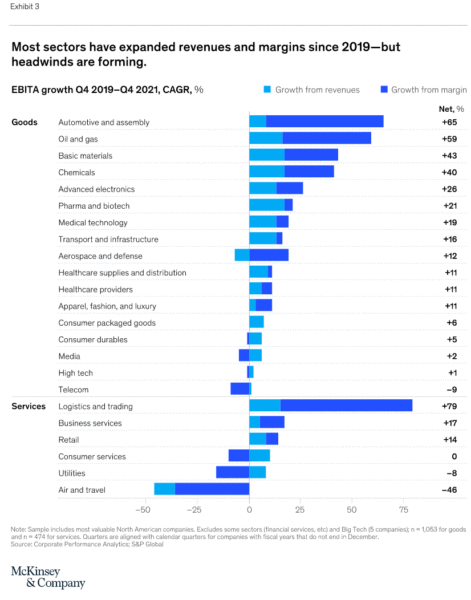
Unless the US economy suddenly finds its footing, we may soon find ourselves in a time when bold decisions could set a company on the road to disproportionate growth and industry leadership. After all the COVID-19 pandemic was a significant and unpredictable disruption, and many companies responded with grace, speed, compassion, and grit to build resilience across six dimensions (Exhibit 4).
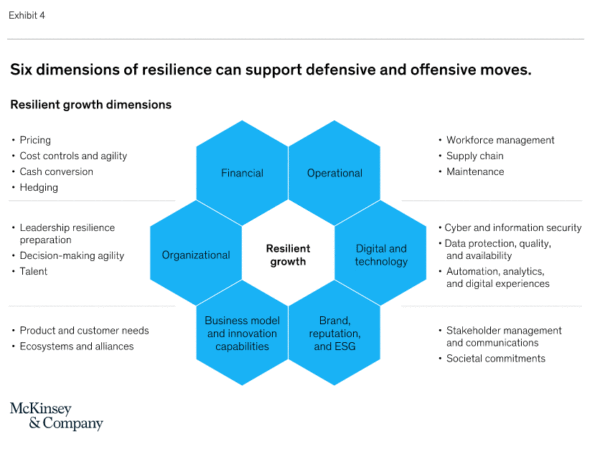
Let’s take a few examples. Our research shows that in the pandemic, high-performing companies invested more time than others in clarifying their goals and setting strategy (business model resilience). They established small, cross-functional teams and empowered them to act (organizational resilience). They spent more time coaching and recognizing employees (also organizational resilience). They made hours and roles more flexible (operational resilience). And they spent more money on collaboration technologies (digital resilience).
The results? These companies found that they could quickly shift the business model: in a matter of weeks, they routinely built new products and services or pivoted entire operations from in-person to remote, adapting to consumer preferences and practical reality—all actions that might have taken a year in the “before times.” A leading hospitality company took immediate steps to diversify into new revenue streams and to focus on winning the 2021 travel season (it succeeded). And a major airline found ways to expand service levels as the travel industry slowly returned to form. Others flexed their new muscles of operational resilience. A medical-device maker was able to exponentially ramp up production of ventilators.
The next time adversity arrives will be different, but companies can build on these core strengths and add new ones. The characteristics of the leading companies’ responses to COVID-19, and resilient leadership more broadly—foresight, response, and adaptation—are precisely what will be needed should the business cycle turn. That’s what history teaches us about outperformers (Exhibit 5). We looked at the top 20 percent of companies as ranked by total shareholder returns during and after the 2008 crisis (see sidebar “Winners through resilience”). They outperformed in the months leading up to the crisis, during it, and then extended their lead in the years that followed.
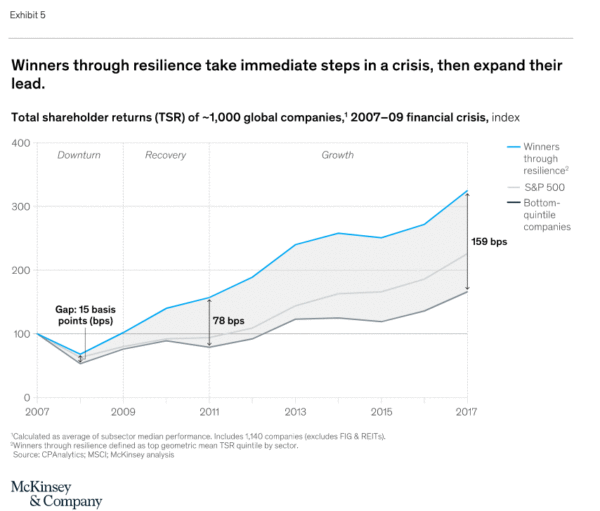
Our goal in studying these companies was to see how their response differed from the rest. They undertook two broad sets of actions to bolster resilience: creating a safety buffer for flexibility and cutting costs before others did. To achieve the first goal, they cleaned up their balance sheets before the trough: they reduced their debt by $1 for every $1 of book capital, while others added more than $3 of debt. To reach the second goal, they cut operating costs by 1 percent before the downturn, while others expanded costs by the same percentage.
Correlation is not causation; we don’t know for sure how much these high-performing companies owe to their resilience-building moves. But in our experience, such moves are essential. Further, both accomplishments allowed companies in this group to adapt by investing into the downturn: they divested early in the cycle and then did about 10 percent more M&A than other companies. The hallmarks of this outperformance were remarkably consistent across sectors (Exhibit 6).
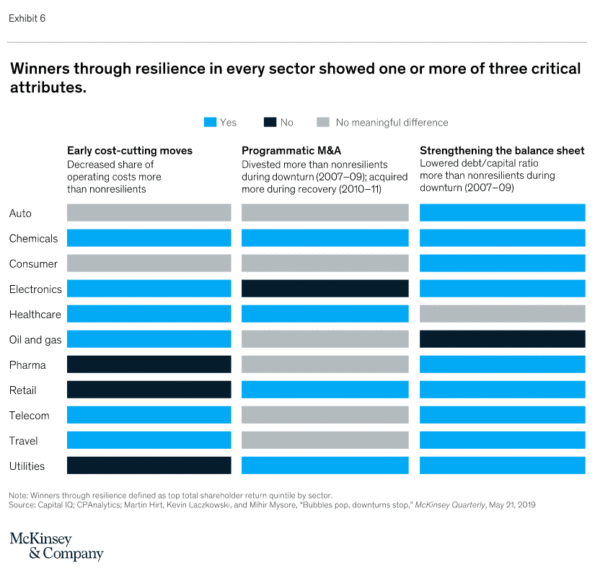
Finding growth in a slowing economy
Management teams have no one-size-fits-all solutions in today’s complex and dynamic environment. Broadly speaking, most companies can look to one of four directions suggested by their profiles. We’ll start with the group best positioned for leadership in the next business cycle.
Poised to thrive
Profile. These companies are at low risk for either commercial or operational disruption. They enjoy relatively inelastic demand for high-margin products, successfully attract and nurture top talent, and have simple supply chains. Like everybody else, they face higher costs from inflation, but they can generally pass price hikes to their customers. Financially, they have strong balance sheets, low leverage, and ample cash.
Options to consider. This is the time to create strategic distance. For example, in core businesses, these companies can fill challenging-to-staff roles—digital experts, engineers, and so on; the pool of available talent will probably deepen as other industries pull back on hiring. Strong companies can also look outward for step-change growth. With valuations off their highs, previously unavailable industry-shaping M&A may be possible. (See sidebar “Creating strategic distance.”)
Resolve to reform
Profile. These companies typically benefit from operational consistency, manage supply chain disruptions skillfully, and maintain stable relations with both customers and suppliers. Most are fortunate to generate margins high enough to help them remain profitable even as a slowing economy eats into growth and inflation increases costs. Such companies may have had trouble attracting talent in recent years, but they have managed to do so, at least in part, and upskilled where possible. Financially, they have modest (or no) leverage and generally manage their working capital well.
Options to consider. For these companies, a shift in the business cycle, if it happens, is an opportunity to go from good to great—a better option than standing pat while rivals leapfrog them. The top team can use this moment to galvanize and mobilize the organization for an ambitious transformation program. That kind of effort is not only about cutting costs but rather changing the way a company operates and building resilience through sweeping improvements in the commercial function, the balance sheet, and the operating model. The talent equation is particularly important: this may be the moment to fill the hard-to-staff roles that have long been open. Pursuing comprehensive change can set a company up for the next cycle, using the transformation to drive innovation, digital investments, and the sustainability agenda. Companies will also find this an opportune time to pursue programmatic M&A in an environment of lower valuations.
Pivot to profit
Profile. The influx of venture capital, growth equity, and public-market funding over the past decade has left the management teams of these companies largely untested in overseeing profitability and cash flows. While such new companies may not have excess leverage, they are consuming cash unsustainably. That model worked well in recent years, when they could build market share with funding rounds at increasing valuations. But those options are not available today or are, at least, less attractive. Such companies may understand neither the real obstacles keeping them from profitability nor the organizational models for a profit-oriented trajectory.
Options to consider. Management can now shift its mindset from growing at any cost to generating cash flows by focusing on profitable growth and zeroing in on the steadiest customers. Depending on the industry, this shift will come in multiple forms. Many of these companies can revisit their sales and marketing approach to enable efficient, profitable growth—not growth at any cost. This is no one-time exercise; it will entail building the long-term capabilities and processes needed to sustain the benefits. In some cases, operations teams can develop plans to deliver products more cost-effectively and identify ways to scale efficiently. All companies with this profile can put a targeted, realistic approach to cashflows and expense management on the priority list.
Fight to survive
Profile. These companies are in (or exposed to) industries sensitive to interest rates, face declining market share, and may have labor, operational, or supply chain challenges. High geopolitical exposure may amplify the risks. Financially, they have high leverage (a debt-to-earnings ratio of more than six, often with tightening covenants), challenged cash positions (an interest coverage ratio of less than two) and unappealing choices for raising further capital. In our analysis, as many as 500 large and midsize US companies could fit this profile.
Options to consider. The management teams of such companies can start with a comprehensive review and then focus in parallel on the P&L and the balance sheet (see sidebar “Taking stock”). Although they must contend with inflation, control spending, build operational resilience, and sweeten the deal to retain the workforce, the challenge is not confined to the P&L. These companies can make working capital a priority and look for opportunities to free up trapped cash, manage long-term liabilities, and exit unprofitable or noncore businesses that do not provide liquidity benefits. They can put in place a taut weekly cash-forecasting process, reconcile forecasts to actuals, and understand and address any material variances that arise. By focusing on both the P&L and the balance sheet, they can not only extend their cash “runway” but also build credibility with their financial stakeholders.
New McKinsey research shows that the best CEOs do things differently. One essential distinction: they focus on beating the odds by making bold moves early. Why wait for trouble to arrive? Leading companies are building resilience now, with intense financial planning followed by decisive plans of action. They are on track to weather the storm and to deliver sustainable, inclusive growth in the years to come.
About the author(s)
Stephan Görner is a senior partner in McKinsey’s Vancouver office. Arvind Govindarajan is a partner in the Boston office, where Alex Panas is a senior partner. Ezra Greenberg is a partner in the Stamford office. Ani Kelkar is an associate partner in the Houston office. John Kelleher is a senior partner in the Toronto office. Ida Kristensen is a senior partner in the New York office, where Linda Liu is a partner. Asutosh Padhi is a senior partner in the Chicago office. Zachary Silverman is a partner in the Atlanta office.































